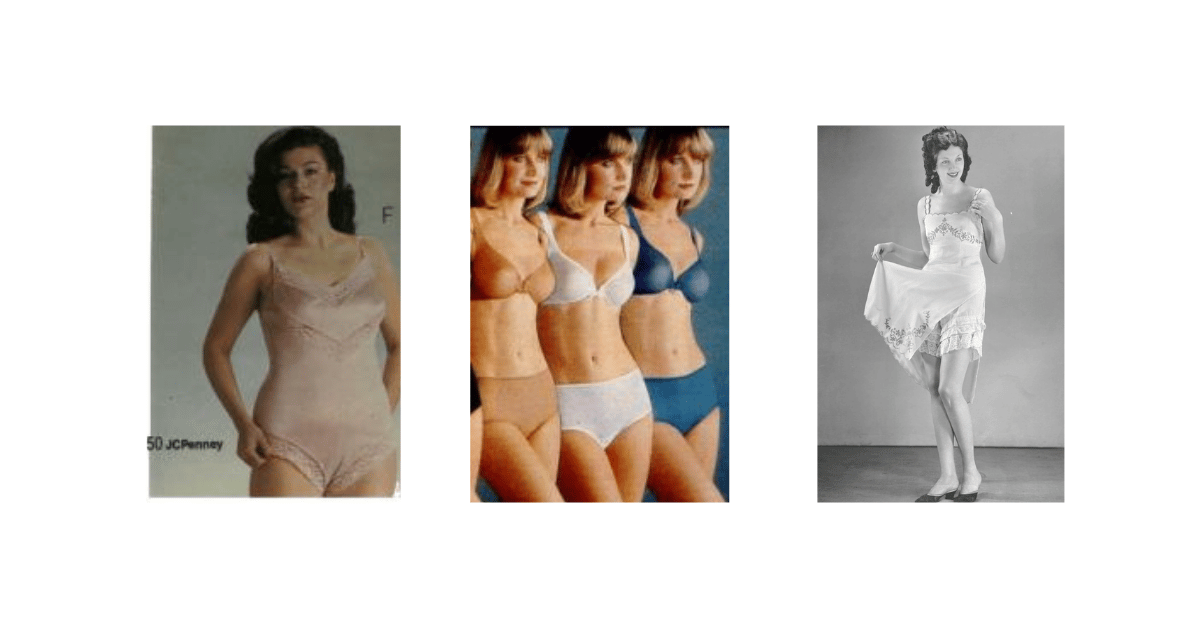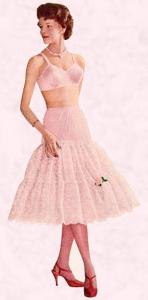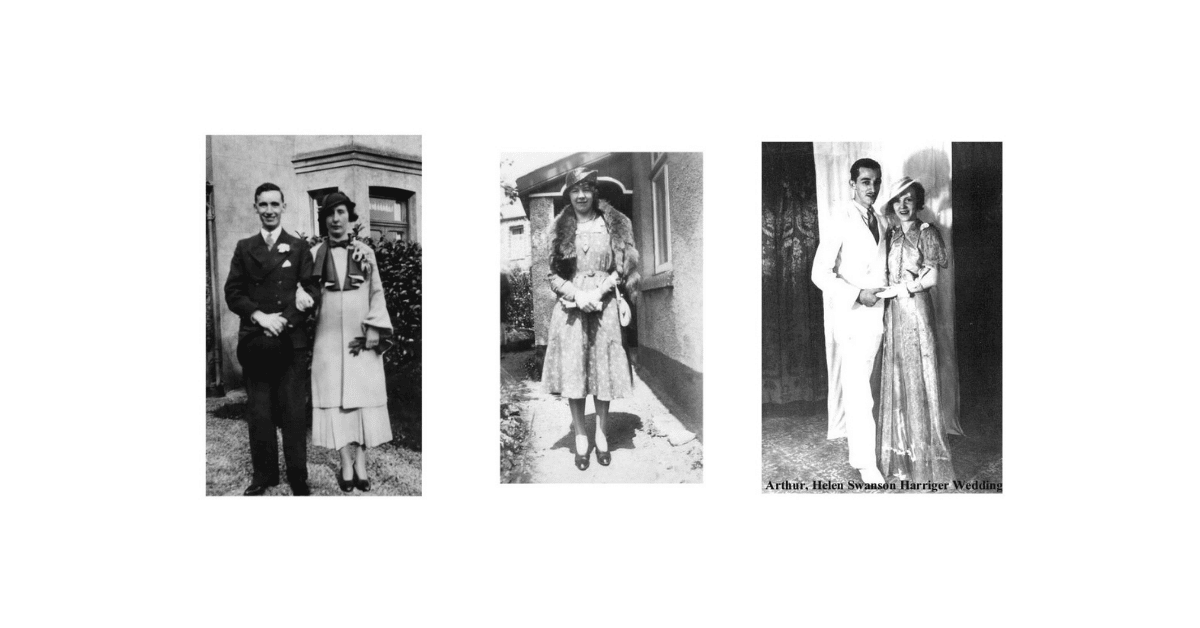By Pauline Weston Thomas for Fashion-Era.com
- The Need for Nether Region Underwear
- The Adoption of Pantaloons
- Knickerbockers
- Victorian Drawers to Combinations and Knickers
- Drawers 1840-76
- Combinations Arrive in 1877
- Knickers Fashion Skirt Knickers
- From Layers and Layers to a Single Layer
- Knickers to Panties 1940s Pants
- Combinations
- Long Johns Pettipants
- Hip Hugger Pants
- Knickers Can Be Naughty
The Need for Nether Region Underwear
During the Regency era women began wearing lower undergarments. From the 1820s onwards drawers were made of more feminine cotton lawn fabric and laced at the waist.
Knickers were quite baggy, which accommodated the split through the crotch, so that despite the opening, the bagginess afforded some modesty when sized correctly.In her book 'Knickers, An Intimate Appraisal', Rosemary Hawthorne records that before 1789 and the French Revolution, long skirts, a petticoat or two, a corset and linen chemise was all the underwear a woman thought desirable or necessary.
As the end of the 18th century approached finer lighter fabrics of lawn, sheer silks and batiste replaced heavier brocade and thicker materials. Thus women began covering their lower regions, simply because it was warmer to wear some undergarments in the cool north European climate.
Prior to the Regency era, quilted petticoats along with a pannier skirt had often been an attractive and visible part of a woman's dress. The fabric used in the skirt was also heavier and the layering meant that the lower half of the body was kept quite warm, furthermore, the heavier cloth used ensured skirts did not billow up.
Regency Underwear
Pantaloons
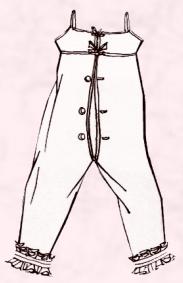
The Empire fashions at the turn of the 19th century were often little more than sheer nightgowns. The practical solution to the discomfort of lighter clothing was to simply adopt the warm undergarment called pantaloons which were already worn by men.
Women's pantaloons were made of light stockinet in a flesh toned nude colour and reached to just below the knee, or even all the way to the ankles. This is why Empire women often appear to be wearing no underwear when seen in paintings of the era. The flesh tone pantaloons acted in just the same way as they do today when a woman wears a flesh-toned bra and briefs under white or pastel trousers and top.
Young women and children were wearing pantalettes under their dresses by 1820.
The drawers were loose and made of two leg sections held together with a tie at the waist. Each pantalette leg was decorated with frills at its bottom edge.
Knickerbockers
The term knickers comes from the book written by Washington Irving in 1809 and called History of New York. He used the pen name Diedrick Knickerbocker. Herr Knickerbocker was supposedly descended from the original Dutch settlers in New York and was lampooned by the well-known caricaturist George Cruikshank. You can see from illustrations in the book that the Knickerbocker men were dressed in loose breeches, strapped or tied at the knee.
From the 1820s onward the breeches were known as knickerbockers and were often used for sports activities. Women borrowed the knickerbockers to wear under their new draughty hooped cage crinolines. Drawers and knickers fashion soon came to mean the same undergarment.
Victorian Undergarments
Victorian Drawers to Combinations and Knickers Drawers 1840-76
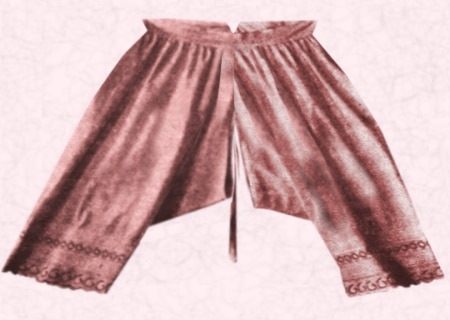
Queen Victoria's standards of propriety were so stringent that she soon ensured that the fashion for knickers became a staple of every Victorian woman's wardrobe. In her younger days she was a leader of fashion, for example, her hairstyle was much copied.
Other styles she favoured such as tartan fabrics in clothing were also followed. Such was her long term influence on Victorian knickers that by the dawn of the Edwardian era in 1901 only the poorest women went without underwear simply due to the extra cost.
You are reading an original article on undergarment history and drawers fashion by Pauline Weston Thomas 2010 only for publication on www.fashion-era.com ©
Drawers Merge Into Knickers
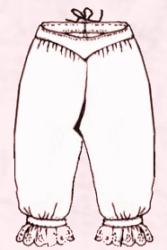
In the 1840s Victorian drawers were plain and reached well below the knees. In the 1850s they became more embellished so that by 1868 decoration on knickers was usual. Often the lower leg edges of Victorian knickers were trimmed with lace and had 5 or 6 tucks above it.
Left - French cambric and broderie anglaise lace Victorian drawers of 1867 and still open-legged. By 1876 the drawer legs of knickers merged to become closed. That is, the open nature of the crotch was closed and an opening of about four inches closed by a few buttons existed instead at the side hip.A revolution had occurred - Victorian drawer legs were no longer separate - they were now fashionable knickers. Fabrics used were changing too and silk, as well as flannel was a popular choice for knickers.
By the late 1870s knickers were accepted and widely worn by women; although as an item of underwear, they were never referred to in polite conversation. It was almost as if they did not exist. Often the knickerbockers were made from brilliant scarlet flannel.
These fabrics such as smooth fine flannel, and alpaca wool had nainsook linings that could be detached for washing. This style of knickers was fashionable underwear until the turn of the 20th century when suddenly the style lacked daintiness.
Combinations Arrive in 1877
From 1877 onward the popular Victorian drawers had new competition from combinations.
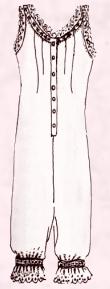
Just as today women wear panties, knickers, thongs, briefs, g-strings, boy-shorts, bodies etc., so women sought the perfect underwear for their sense of self in Victorian times. The undergarment competition came in the form of a new underwear item called combinations. Combinations were first developed as a Victorian undergarment in 1877. They were initially made from linen, silk, merino, calico, cambric or nainsook in flesh pink tones or cream colours. The combinations were made more popular as a style in the late 1880s by Dr Jaeger and his underwear versions were made of fine wool.
All-in-one Combination
The all-in-one undergarment called combinations, and shown left, consisted of a camisole bodice attached to drawers. Its design eliminated the need for a chemise and the latter versions of combinations were frillier and prettier garments that merged into lingerie, making them more exotic in their appearance. By 1892 other variations made of silk or fine muslin were the preferred fabrics.
Knickers
By 1895 knicker legs became very wide and decorated with frills at the knee. In general the width of the knicker leg was about 20 inches around the knee with a 10-inch lace frill. The knickers were easily accommodated under the wide petticoats and equally full wide skirts of the 1890s era.

Edwardian Cami- Knickers
In the early Edwardian era the frilled fancy knickers were often worn over the combinations.

Early Cami-Knickers.By 1905 the majority of fashions for using other fabrics been replaced by undergarments made solely from the finest lawn or cambric.
Directoire Knickers
Knicker styles have generally conformed to the silhouette line of an era, so that by 1908, as the silhouette slimmed to a column, these closer fitting knickers called the Directoire style soon became the norm.
Combinations became less usual, but were still worn and available for many years beyond the Edwardian era. Some example of combination styles available in both 1939 and 1958 are shown further below. By the 1930s the combinations were akin to tights they could be so close fitting.
Skirt Knickers - French Knickers
In the flapper era, the latest knicker fashion was to wear either the new skirt knickers also known to us as French knickers (but then often open-legged) or the closer body skimming fitting Directoire knickers. Right - French Skirt Knickers Image from a 1920 Copy of Everywomen. The volume of undergarment types available in this transitional era of dress is positively baffling as new forms of underwear were devised to accommodate the shorter and more fitted lines of clothing.

A button and loop or tie fastening added here and there to hold the hem of a chemise underskirt together soon created the chemi-knickers in 1917 and these evolved into new style cami-knickers. Women passionate about equality in this era were just as passionate about abandoning old-fashioned underwear styles for new innovative lines and with even newer-sounding names. Right - Flapper's Cami-Knickers 1928. Closed Directoire knickers with flap poppers were attached to a camisole and then called cami-blockers.
How undergarments were fastened usually helped define their retail selling name, but the leg volume of the knickers often made the descriptive differences.
Combinations
Combination Vests and Chemise Panty
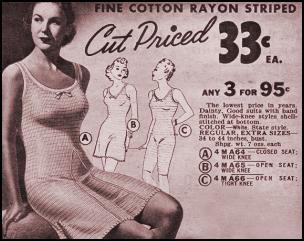
This 1939 open seat vest (C) had a back opening and was all-in-one with legs from thigh to knee. They appear to be called vests in the advert and defined by having either closed or open seats (as in astronaut/airman fighter parachutists suits), yet they still seem to be in effect modern ladies combinations.
The decades change and so do the undergarment names but their underlying purposes of comfort, warmth and fashion remain constant.
You are reading an original article on undergarment history and drawers fashion by Pauline Weston Thomas 2010 only for publication on www.fashion-era.com ©
100 Years of Combinations
By 1958 combinations looked like the blue slip garment far right.
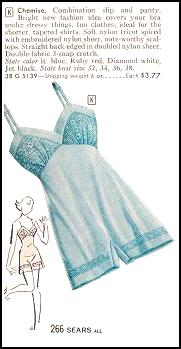
If Rayon had been the fabric for underwear in the nineteen twenties and thirties, then for the fifties, sixties and seventies nylon (polyamide) gained a new grip on lingerie After that natural and luxury man made fabrics gained a following again.
This chemise combination was in a modern easy care nylon and described as a soft nylon tricot (knit jersey) which was basically a long chemise with panty legs attached, but in a briefer form than pieces of previous decades.

One could also suggest that the 1980s teddy right is also in this combination category and was indeed an updated version, but exceptionally brief compared to the combinations of a 100 years earlier in 1877.
A Modern Combination
1980s Lingerie Teddy - 1982
The teddy, as an all in one body garment and not the cuddly toy, became a hugely desirable item of underwear and used in many bedroom scene in Dallas or Dynasty TV soap opera shows. Teddies were usually made of silk or satin, and in mass-produced terms silky polyesters and crêpe-de-chine fabrics. They offered little or no bra or tummy control support but were luxury lingerie items. The body beneath was supposed to be already perfectly sculpted from 'feel the burn' gym workouts. The Teddies almost always fastened beneath the legs with press studs or hooks and bars.
From Layers and Layers to a Single Layer
Changes in outer clothes and in underwear had begun prior to World War 1. The 1914-18 war simply accelerated and developed new ideas as war always does. The number of layers of clothes on the body was gradually being reduced as the 20th century progressed. War work had emphasised the fact that for an active life, women needed more freedom of movement and so gradually as freer movement became an ideal under clothing began to match it.
Female undergarments began to contract. By 1917 the brassiere gained mass popularity and thinner lighter weight fabrics used for knickers and a simple camisole top that could button to the knickers meant that often this was all a woman wore beneath a lined garment. This was all in complete contrast to the body of heavy underclothes worn only 50 years previously.
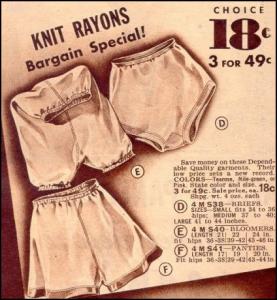
Top clothing changed to the extent that the skin itself became fabric. Previously much of the body had been covered, but nude limbs now acted almost like a fabric, even more so once it became fashionable to enhance skin with a suntan thus bringing the ability to change even the hue of flesh as climatic conditions allowed.
As the top outer garments were by then little more than a single layer dress or suit, the underwear needed to feel smoother for comfort. A scratchy wool top garment was more likely to irritate and chafe the skin beneath with fewer layers of undergarments.Left - The ultimate in chic undies - smoother underwear for smoother top clothes. Catalogue Underwear of 1949. Knit Rayon Briefs (D), Knit Rayon Bloomers (Elasticated Leg Directoire Knickers - E) and Knit Rayon Panties (C).The smoother fabric that proved ideal at this point was artificial silk made from rayon.
It was known then as art silk.Simply put, artificial silk was made from a complex process of putting wood cellulose chips into chemicals for several days until that created a viscous solution. The solution then called viscose was thick enough to be extruded into a wet bath of more chemicals and it solidified on contact with the chemical bath. It left behind an artificially regenerated man made fibre that set on contact with the chemicals.
Further treatments helped create a whole range of fibre variations as the century progressed. Artificial silk was affordable and available to all classes. A similar, but improved product called Cupro is available to us today.

Knickers to Panties
The name of knickers changed in the 1920s. In 1924 knickers became known as panties and by 1930 they were called panty briefs.
The underwear became smoother in line and this was an essential necessity under the new slinkier bias cut garments of the 1930s. The length of knickers varied with the fashions.
By 1927 they reached far above the knee, but so then did the top skirts! Once skirts were longer, knickers ended just above the knee again. By 1934 panties were tailored to fit the body contours giving a very smooth line and a style we would recognise today. Silk and merino was a desirable mix for absorbent underwear.
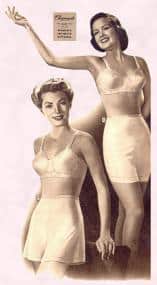
1940s Pants
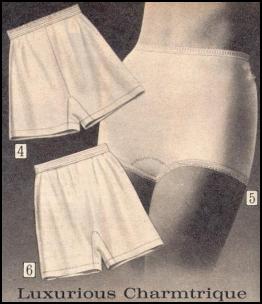
Art silk remained popular, but in the 1940s and 1950s many pants were either made of cotton which could be boiled, or made of silk and kept to be worn for special occasions. Nylon (polyamide) was also a major player in the development of modern underwear. It was heavily promoted as easy launder since it dried far faster than rayon or cotton products.
Ironing was often unnecessary or minimal with a cool iron. Cotton items, broderie anglaise lace products for example were scratchy by comparison and need heavy ironing after lots of dampening down.
Cotton items like knit jersey aertex interlock white cotton knickers or silk and merino mix knickers were comfortable in a Bridget Jones manner, but by the sixties considered rather old fashioned. However often they were the only natural fabric alternatives. The new pants were in Charmtrique (left) and Charmode (right).Above Right & Left - Catalogue Underwear of 1949. Knit Rayon Briefs, Knit Rayon Bloomers and Knit Rayon Panties.
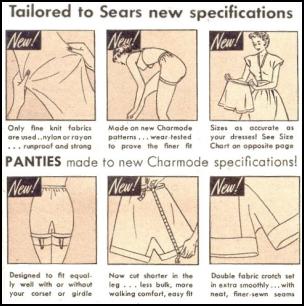
Sears Catalogue made a great case for their specially made panties made to new Charmode specifications. The advert went to great length to explain that only fine knit fabrics were used and that both the nylon and rayon construction they used was run proof and strong. The pants were wear-tested to prove the finer fit, and manufacturers claimed sizes were as accurate as dress sizes. This makes one wonder if the pants fit before this era was as fulsome as a Shalwar Kameez.
The advert above went on to explain that the Charmode pants were designed to fit smoothly with or without a girdle and that the new cut of what was then a short leg gave a pair of pants with less bulk and easy fit.The advertisement for panties made from 100% du Pont Nylon and available by catalogue heavily promoted the better characteristics of the fibre.
One of the characteristics of nylon is that its fibres are hydrophobic, this has the undesirable effect of repelling perspiration, make the wearer feel uncomfortable in warm conditions. Perspiration that cannot be wicked away by the fabric oxidises and causes odours.
This underwear really did need daily washing. But manufacturers were quick to point out of the benefits too, as the catalogue promotion advertisement above shows, panty garments could be made very close fitting to the body and help create smoother lines beneath clothes.
1950s & 1960s
The Mad Men look we all love today was based around good under foundation garments such as these shown. The pointed bra, the panty leg roll-on and the nylon lace bouffant net petticoat were the hidden part of the well-groomed woman of the early 60s. Women typically wore pants like these fancy nylon tricot briefs.
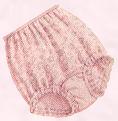
In 1958 these stockings cost 94cents and the pink panties cost $1.47. The fabulous net lace tiered bouffant petticoat cost $4.47, the Dacron (polyester) with Pima cotton and nylon bra was $2.83 and the nylon power net, acetate and Lastex panty girdle $4.77. At this time Lycra and Spandex were still in the laboratory, but hit the big time in mass manufacture in the mid-sixties.
.The big fibre of the sixties had been nylon closely followed by Acrylic or Orlon in knitwear.
A big selling point of nylon had been the pastel colours especially bright white, its drip-dry nature and quick drying plus the bonus of a close stretch fit in the right fabric construction like the stretch lace pants below.
1960s Pants
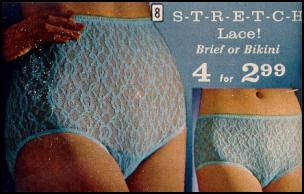
By the 1960s totally nylon knickers were usual, and the all nylon gusset was in due course replaced by a double gusset and often a different fabric such as cotton or cotton jersey for greater hygiene and comfort.
But the pretty lace fabrics that stretched and moulded to the body were novel when compared to utilitarian styles of the second world war rationing era.
The blue lace panties left were called briefs when they reached the waist and when cut lower they were mostly referred to as hip huggers. Later as they became cut even lower they were often called bikini panties.
Winter Warmer Bloomers
Long Johns, Pettipants or Demi-Johns
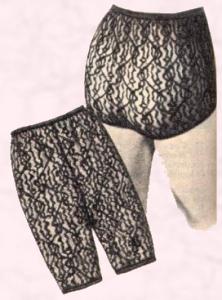
Nylon stretchy lace was used to make elongated pants that almost reached the knee. They were known as Long Johns, Demi Johns, winter warmers or pettipants.
The just above knee pants were a practical solution in winter to keep legs warmer. They were also made in plain ribbed nylon knit fabric and trimmed with contrast lace. Floral print versions were also de rigueur in a decade known for flower power.
1965-1970s Hipster Briefs
By the 1970s cotton gussets were added to nylon briefs for comfort and better hygiene. In this era various permutations on the bikini bottom took panties lower and lower down the hipline and higher and higher up the thigh. These were hipsters or hipster briefs and they featured leg variations from straight cut to high cut became usual.Below Left - High waist green nylon panty briefs with applied lace c1969.
Below Right - Late 1960s alternatives were these 'modern' hip huggers shown in an adverts from c1967-8.
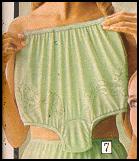
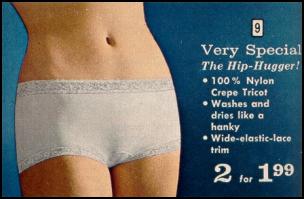
Hipster styles of panties became fashionable in floral printed fabrics, bold colours and flesh toned knickers were the new must have.
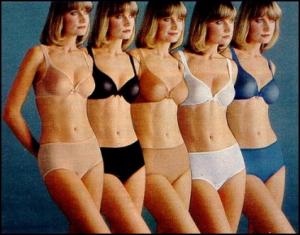
By the 1980s, eco conscious superfine cotton jersey knickers were back in fashion, but so were slinky silk or polyester satin or crepe de chine French knickers dripping in lace. Below Winter 1982 J C Penney Catalogue - Basic Panty Briefs.

1980s Lingerie Camisoles and French Knickers
The teddy an all-in-one body garment shown further up in the combinations section was a popular piece of lingerie alongside the revival of separate camisoles and lace-embellished French Knickers. See above.
Designer Knickers
Designer knickers, which were very functional pieces in wash and wear materials, became usual with designer brand names suddenly getting attention. Sloggi and Calvin Klein were popular panty brief names of the 1980s to the extent of letting show the designer woven waistband.
CK underwear became a known brand name worldwide as it was constantly advertised on the highly visible waistlines of men and women everywhere.
Briefer and Briefer Panties
By this time a wide range of pant styles getting briefer and briefer had arrived. The cut of the leg once considered highline was now renamed low cut to accommodate an even more highly cut leg as shown left.
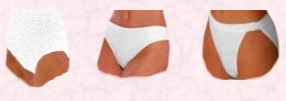
Tangas
The brief was no longer a brief, it was a patch of fabric.Skimpy bits of fabric called tangas, thongs and strings merely covered private parts or sometimes barely covered the area and so made it necessary for extreme techniques of hair removal. The world today is only too familiar with waxing and G strings, once totally the province of strippers. Now it became a norm for many consumers in the 1990s particularly younger females who favoured low rise trousers and aped the starlets of erotic films. Previous to that, such styles were often kept for the privacy of the bedroom rather than everyday wear.Right - A Red Thong for 2010 by Matalan.
The world today is only too familiar with waxing and G strings, once totally the province of strippers. Now it became a norm for many consumers in the 1990s particularly younger females who favoured low rise trousers and aped the starlets of erotic films. Previous to that, such styles were often kept for the privacy of the bedroom rather than everyday wear.Right - A Red Thong for 2010 by Matalan.
G-String Underwear
A G-string has a string, whilst a thong has a small bit of fabric an inch or so wide coming to a y shape at the waistband. Thongs can be made of silk, nylon, leather, cotton etc and also be adorned with diamante, lace or embroidery.
The string parts of G-strings can be made of decorative pieces such as rhinestone belts and are often designed to be seen when worn. The initial acceptance of thongs was credited to the disappearance of visible panty lines when worn under trousers. In the early noughties they were worn under low trousers to be visible, but the look became passé as ladylike style and Mad Men fashion returned.
South American women favoured these styles long before they gained mass acceptance in Europe. Their popularity among young western women may be due to the fact that many simply cannot recall how similar these often visible G-strings appear to older women who compare them in their mind to the never to be seen elastic sanitary belts. This was of course long before sanitary wear had wing wraps, were adhesive backed, or were replaced by tampon varieties.
Famous Lingerie Brands
Famous makers of attractive underwear still include Janet Reger, Agent Provocateur, Rigby and Peller, La Senza, La Perla, Marks and Spencer, Gossard, Charnos, Lejaby, Victoria's Secret, Playtex, Warners, Triumph and Berlei.

Pants can be pretty and are then thought of as lingerie, but they are also designed to be functional. This pair of white briefs are knickers with a difference - the fabric has no hems and has no hemmed fabric edge but one that does not unravel nor show a ridge or visible panty line (VPL) beneath slinky fitting top garments.Right - White Perfect No Visible Panty Line Low Rise Shorts Marks & Spencer.
Knickers Can be Naughty
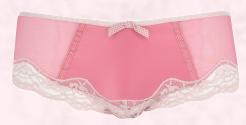
Pink vintage style lingerie £18/£8 Available From September 2010 Marks & Spencer.Knickers and their styles have always been a subject for fun and amusement in seaside postcards, cartoons and the butt of jokes about women who have let themselves go or lost interest in sex.
This has been emphasised even more in the past 20 years as some styles of knickers have moved through stages that have reduced the amount of fabric needed to make an item so small it can appear to consist of nothing more than a bit of strapping reminiscent of a 1950's sanitary belt.
Some Noughties Knicker Fashion Statistics
In the UK in 2003 Marks and Spencer the clothing store had coverage on one third of the British lingerie market. This made it then the first stop in Britain when a consumer sought underwear, with the average woman buying 8 pairs of knickers a year and the store selling 60 pairs a minute. In the UK Marks and Spencer then was selling 25 million pairs of knickers every year, with 4.8 million women confessing to owning a pair of large Bridget Jones style pants or full briefs as Marks describes them.

Apparently Marks and Spencer's underwear (pants) is one of the things UK ex-pats miss most when living abroad. No doubt they will be relieved that Marks & Spencer now ship goods internationally as well as within UK. Their top purchasing countries abroad include The United States, Australia, Canada, France, Germany, New Zealand and Spain.
The knicker elastic M&S use has to survive 1000 washes. The admiring glances they get - well that's up to you.... maybe not so many glances after 1000 washes....
Mrs Amelia Bloomer
And finally if you came to this page seeking information about bloomers then you need to know more about Mrs Amelia Bloomer 1818-94. Mrs Bloomer promoted the wearing Bloomers and bloomer suits.
You can also see other versions of Victorian and Edwardian bloomer fashion history on the early swimwear page.
Page Added June 2005. Updated July 2010. Ref P781.
Footnote :-This page was partially based on content I updated from a dissertation I first wrote in 1979. The dissertation a Comparative Study Between the Rôles of the Edwardian Hostess and the Edwardian Seamstress looked at the symbolism behind Edwardian dress and the rôles of women in Edwardian society. In particular, it examined the rôle and high lifestyle of Edwardian society hostesses compared with the degrading working conditions and impoverished lifestyle of the seamstresses that made clothes for hostesses.
